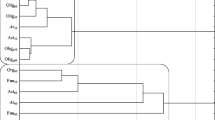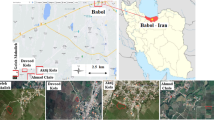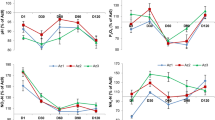Abstract
The aim of this study was to find what dosages of linuron introduced into soil can be tolerated by microorganisms, and whether a dosage equal to 100-times higher than the predicted environmental concentration (PEC) is harmful. A pot study was performed to determine the effects of the herbicide at PEC (4 mg kg−1), 5 times PEC (20 mg kg−1), and 100 times PEC (400 mg kg−1) on substrate-induced respiration (SIR), four enzyme activities (dehydrogenase, acid and alkaline phosphatases, and urease), ammonification and nitrification rates, plate counts of total bacteria, fungi, N2-fixing bacteria, nitrifiers and denitrifiers, and distribution of r- and K-strategists in sandy soils of different texture throughout 28 days of incubation. Linuron increased SIR and ammonification, especially at 100 times PEC. In contrast, a decrease in nitrate concentrations was detected in both soils treated with the highest dosage of linuron. Although some changes in microbial numbers were ascertained, they were transient (i.e. total bacteria, N2-fixing bacteria and nitrifiers) or not significant (i.e. total fungi and denitrifiers). Among the enzymes tested, dehydrogenase was the most sensitive to linuron, showing decreased activity for all treatments and two higher dosages in the loamy sand (LS) and sandy loam (SL) soils, respectively. The addition of 100 times PEC of linuron to LS resulted in the domination of slow-growing K-strategists on days 1 and 14. However, r-strategists dominated on both days 1 and 28 in SL. Our results indicate that linuron may disturb indigenous soil microorganisms, especially when released at high concentrations.



Similar content being viewed by others
References
Accinelli C, Screpanti C, Dinelli G, Vicari A (2002) Short-time effects of pure and formulated herbicides on soil microbial activity and biomass. Int J Environ Anal Chem 82:519–527
Accinelli C, Dinelli G, Vicari A, Mallegnir R (2004) Metolachlor and linuron soil degradation after repeated applications under laboratory conditions. Agrochimica 48:132–140
Alef K (1995) Dehydrogenase activity. In: Alef K, Nannipieri P (eds) Methods in applied soil microbiology and biochemistry. Academic, London, pp 228–231
Araújo ASF, Monteiro RTR, Abarkeli RB (2003) Effect of glyphosate on the microbial activity of two Brazilian soils. Chemosphere 52:799–804
Badiane NNY, Chotte JL, Pate E, Masse D, Rouland C (2001) Use of soil enzyme activities to monitor soil quality in natural and improved fallows in semi-arid tropical regions. Appl Soil Ecol 18:229–238
Breugelmans P, D’Huys PJ, De Mot R, Springael D (2007) Characterization of novel linuron-mineralizing bacterial consortia enriched from long-term linuron-treated agricultural soils. FEMS Microbiol Ecol 62:374–385
Caux PY, Kent RA, Fan GT, Grande C (1998) Canadian water quality guidelines for linuron. Environ Toxicol Water Qual 13:1–41
Chen S-K, Edwards CA, Subler S (2001) A microcosm approach for evaluating the effects of the fungicides benomyl and captan on soil ecological processes and plant growth. Appl Soil Ecol 18:69–82
Cycoń M, Piotrowska-Seget Z, Kaczyńska A, Kozdrój J (2006) Microbiological characteristics of a loamy sand soil exposed to tebuconazole and λ-cyhalothrin under laboratory conditions. Ecotoxicology 15:639–646
De Leij FAAM, Whipps JM, Lynch JM (1993) The use of colony development for the characterisation of bacterial communities in soil and roots. FEMS Microbiol Ecol 27:81–97
Dejonghe W, Berteloot E, Goris J, Boon N, Crul K, Maertens S, Höfte M, De Vos P, Verstraete W, Top EM (2003) Synergistic degradation of linuron by a bacterial consortium and isolation of a single linuron-degrading Variovorax strain. Appl Environ Microbiol 69:1532–1541
Dinelli G, Vicari A, Accinelli C (1998) Degradation and side effects of three sulfonylurea herbicides in soil. J Environ Qual 27:1459–1464
Domsch KH, Jabnow G, Anderson TH (1983) An ecological concept for the assessment of side-effects of agrochemicals on soil microorganisms. Res Rev 86:65–105
el Fantroussi S, Verschuere L, Verstraete W, Top EM (1999) Effects of phenylurea herbicides on soil microflora communities estimated by analysis of the 16S rRNA gene fingerprints and community level physiological profiles. Appl Environ Microbiol 65:982–988
El-Ghamry AM, Xu JM, Huang CY, Gan J (2002) Microbial response to bensulfuron-methyl treatment in soil. J Agric Food Chem 50:136–139
Filip Z (2002) International approach to assessing soil quality by ecologically-related biological parameters. Agr Ecosyst Environ 88:169–174
Gianfreda L, Sanninio F, Ortega N, Nannipieri P (1994) Activity of free and immobilzed urease in soil: effects of pesticides. Soil Biol Biochem 26:777–784
Grenni P, Caracciolo AB, Rodrίguez-Cruz MS, Sánchez-Martίn MJ (2009) Changes in the microbial activity in a soil amended with oak and pine residues and treated with linuron herbicide. Appl Soil Ecol 41:2–7
Ismail BS, Yapp KF, Omar O (1998) Effects of metsulfuron-methyl on amylase, urease, and protease activities in two soils. Aust J Soil Res 36:449–456
Jorge M, Martin A, Carballas T, Diaz-Ravina M (2007) Atrazine degradation and enzyme activities in an agricultural soil under two tillage systems. Sci Total Environ 378:187–194
Kara EE, Arli M, Uygur V (2004) Effects of the herbicide Topogard on soil respiration, nitrification, and denitrification in potato-cultivated soils differing in pH. Biol Fertil Soils 39:474–478
Lin X, Zhao Y, Fu Q, Umashankara ML, Feng Z (2008) Analysis of culturable and unculturable microbial community in bensulfuron-methyl contaminated paddy soils. J Environ Sci 20:1494–1500
Lupwayi NZ, Harker KN, Clayton GW, O’Donovan JD, Blackshaw RE (2009) Soil microbial response to herbicides applied to glyphosate-resistant canola. Agric Ecosyst Environ 129:171–176
Marsh JAP, Davies HA (1981) Effects of dichlorprop and mecoprop on respiration and transformation of nitrogen in two soils. Bull Environ Contam Toxicol 26:108–115
Martinez-Toledo MY, Salmerón Y, Rodelas B, Pozo C, Gonzalez-López J (1996) Studies of the effects of the herbicide simazine on microflora of four agricultural soils. Environ Toxicol Chem 15:1115–1118
Martinez-Toledo MY, Salmerón Y, Rodelas B, Pozo C, Gonzalez-López J (1998) Effects of the fungicide Captan on some functional groups of soil microflora. Appl Soil Ecol 7:245–255
Marx M-C, Kandeler E, Wood M, Wermbter N, Jarvis SC (2005) Exploring the enzymatic landscape: distribution and kinetics of hydrolytic enzymes in soil particle-size fraction. Soil Biol Biochem 37:35–48
Monkiedje A, Ilori MO, Spiteller M (2002) Soil quality changes resulting from the application of the fungicides mefenoxam and metalaxyl to a sandy loam soil. Soil Biol Biochem 34:1939–1948
Nannipieri P, Kandeler E, Ruggiero P (2002) Enzyme activities and microbiological and biochemical processes in soil. In: Burns G, Dick RP (eds) Enzymes in the environment: activity, ecology and applications. Dekker, New York, pp 1–33
Peruci P, Dumontet S, Bufo SA, Mazzatura A, Casucci C (2000) Effects of organic amendment and herbicide treatment on soil microbial biomass. Biol Fertil Soils 32:17–23
Pozo C, Salmerón Y, Rodelas B, Martinez-Toledo MY, Gonzalez-López J (1994) Effects of the herbicide alachlor on soil microbial activities. Ecotoxicology 3:4–10
Ratcliff AW, Busse MD, Shestak CJ (2006) Changes in microbial community structure following herbicide (glyphosate) addition to forest soils. Appl Soil Ecol 34:114–124
Saeki M, Toyota K (2004) Effect of bensulfuron-methyl (a sulfonylurea herbicide) on the soil bacterial community of a paddy soil microcosm. Biol Fertil Soils 40:110–118
Sannino F, Gianfreda L (2001) Pesticide influence on soil enzymatic activities. Chemosphere 45:417–425
Schuster E, Schröder D (1990) Side-effects of sequentially-applied pesticides on non-target soil microorganisms: field experiments. Soil Biol Biochem 22:367–373
Seghers D, Verthé K, Reheul D, Bulcke R, Siciliano SD, Verstraete W, Top EM (2003) Effect of long-term herbicide applications on the bacterial community structure and function in an agricultural soil. FEMS Microbiol Ecol 46:139–146
Snel JFH, Vos JH, Gylstra R, Brock TCM (1998) Inhibition of photosystem II (PSII) electron transport as a convenient endpoint to assess stress of the herbicide linuron on freshwater plants. Aquat Ecol 32:113–123
Sørensen SR, Bending GD, Jacobsen CS, Walker A, Aamand J (2003) Microbial degradation of isoproturon and related herbicides in and below agricultural fields. FEMS Microbiol Ecol 45:1–11
Tabatabai MA, Bremner JM (1969) Use of p-nitrophenylphosphate to assay of soil phosphatase activity. Soil Biol Biochem 1:301–307
Taiwo LB, Oso BA (1997) The influence of some pesticides on soil microbial flora in relation to changes in nutrient level, rock phosphate solubilization and P release under laboratory conditions. Agr Ecosyst Environ 65:59–68
Tenuta M, Beauchamp EG (1996) Denitrification following herbicide application to a grass sward. Can J Soil Sci 76:15–22
Valle A, Boschin G, Negri M, Abbruscato B, Sorlini C, D’Agostina A, Zanardini E (2006) The microbial degradation of azimsulfuron and its effect on the soil bacterial community. J Appl Microbiol 101:443–452
Vienneau DM, Sullivan CA, House SK, Stratton GW (2004) Effects of the herbicide hexazinone on nutrient cycling in a low-pH blueberry soil. Environ Toxicol 19:115–122
Wyszkowska J, Kucharski J (2004) Biochemical and physicochemical properties of soil contaminated with herbicide Triflurotox 250 EC. Pol J Environ Stud 13:223–232
Yang C, Sun T, He W, Zhou Q, Chen S (2007) Single and joint effects of pesticides and mercury on soil urease. J Environ Sci 19:210–216
Zabaloy MC, Garland JL, Gómez MA (2008a) Microbial respiration in soils of the Argentina pampas after metsulfuron-methyl, 2, 4-D and glyphosate treatments. Commun Soil Sci Plant Anal 39:370–385
Zabaloy MC, Garland JL, Gómez MA (2008b) An integrated approach to evaluate the impacts of the herbicides glyphosate, 2, 4-D and metsulfuron-methyl on soil microbial communities in the Pampas region, Argentina. Appl Soil Ecol 40:1–12
Acknowledgements
We are grateful to Anna Kaczyńska and Maria Siuta for laboratory assistance.
Author information
Authors and Affiliations
Corresponding author
Rights and permissions
About this article
Cite this article
Cycoń, M., Piotrowska-Seget, Z. & Kozdrój, J. Linuron effects on microbiological characteristics of sandy soils as determined in a pot study. Ann Microbiol 60, 439–449 (2010). https://doi.org/10.1007/s13213-010-0061-0
Received:
Accepted:
Published:
Issue Date:
DOI: https://doi.org/10.1007/s13213-010-0061-0




